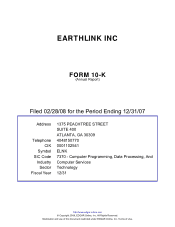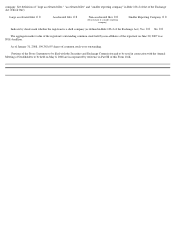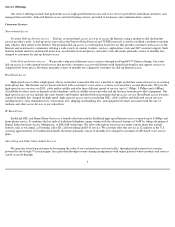Earthlink 2007 Annual Report Download - page 9
Download and view the complete annual report
Please find page 9 of the 2007 Earthlink annual report below. You can navigate through the pages in the report by either clicking on the pages listed below, or by using the keyword search tool below to find specific information within the annual report.
Network Infrastructure
We provide subscribers with Internet access primarily through third-party telecommunications service providers. Our main provider for
narrowband services is Level 3 Communications, Inc. We have agreements with Covad Communications Group, Inc. ("Covad"), AT&T Inc.
("AT&T"), Qwest Corporation ("Qwest") and Verizon that allow us to provide DSL services. We also have agreements with Time Warner
Cable, Bright House Networks and Comcast Corporation ("Comcast") that allow us to provide broadband services over each company's cable
network in substantially all Time Warner Cable and Bright House Networks markets and certain Comcast markets. We rely on Covad's line-
powered voice access to provide our IP-based voice services.
We maintain a leased backbone connecting multiple cities and our technology centers. Our backbone is a networked loop of connections
that we have acquired the right to use. Through a combination of backbone, peering and transit, our network is capable of supporting more than
five gigabits per second of traffic at peak.
New Edge's network is comprised of ATM/frame relay/DSL switches in central office collocations. In addition, New Edge has access under
wholesale agreements to additional central offices throughout the U.S. It has interconnection agreements with all major local exchange carriers
to lease DSL and T-1 unbundled network elements, as well as commercial services agreements with regional bell operating companies
("RBOCs"), competitive local exchange carriers ("CLECs"), and cable and satellite service providers to provide last mile connectivity onto its
network. The network provides coverage via frame relay, DSL, and/or T-1 access to service small and medium sized businesses and carriers.
Regulatory Environment
Overview
The regulatory environment relating to our business continues to evolve. A number of legislative and regulatory proposals under
consideration by federal, state and local governmental entities may lead to the repeal, modification or introduction of laws or regulations which
do, or could, affect our business. Significant areas of regulation for our business include Internet access regulation, telecommunications
regulation and CLEC regulation.
Internet Access Regulation
Narrowband Internet Access
The regulatory environment for narrowband Internet access services, such as our dial-up ISP services, is well established. Beginning in the
1970s, the Federal Communication Commission's ("FCC's") policy has been to classify narrowband Internet access services as "information
services", which are not subject to traditional telecommunications services regulation, such as licensing or pricing regulation. Under this
framework, ISPs are assured access to the narrowband telecommunications transmission service of telephone carriers needed to provide
narrowband Internet access information services.
One potential risk to our dial-
up business would be a change to the rules governing how charges for traffic on telecommunications networks
are levied. Currently, narrowband Internet access is not subject to the FCC's carrier access charge regime, which levies per-minute charges for
traffic that uses the local telephone network. Any change to these rules that would apply per-minute carrier access charges to dial-up Internet
access traffic would significantly impact our costs for this service.
Broadband Internet Access
In contrast to narrowband Internet access, the FCC classifies broadband Internet access as a single, commingled information service,
whether provided over DSL by telephone companies or over cable
5






















